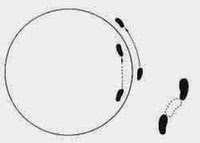It has been awhile since we have posted an informational item on Baguazhang. Following is an interesting article on the functionality of Baguazhang.
###
The Function of Circular Walking in Baguazhang
WeiQunjie
To walk in a circle is one of the most important techniques of baguazhang practice. With a good mastery of it, you will improve your baguazhang performance benefits in the following two ways
First of all, the circular movements of the feet may help improve your health and this function is served by the change of direction, the repetition of movements, the coordination of the dynamic and the static and the lowering of qi into the dantian, an area of 5 cm below the navel. In so doing, you can improve your internal and external exercises and moreover make them better coordinated. Specifically, internal exercise is to dredge channels and collateral passages, promote blood circulation and improve the function of internal organs while external exercise, which consists of the techniques executed with the hands, eyes, trunk and feet, is to limber up your muscles and joints and strengthen your physique. To walk in a circle can provide you with an opportunity of adjusting your breath. But there are some points to remember when you do the circular movements with your feet.
They are (1) Clear away all distracting thoughts, concentrate their energy on practice, relax your muscles, lower qi into the dantian, look straight at the center of circle and coordinate your breath and body movement; (2) try to avoid exerting brainless force; (3) make abdominal respiration your main breathing method; (4) keep your breath long and enough and your movements slow and natural. If you practice according to the above-mentioned principles for a long time, you will probably find that your qi and blood flow freely, your internal organs function effectively and your internal organs function and your lower limbs become strong and flexible.
When you have benefited so much from your practice, you will be able to prevent yourself from contracting premature osteoporosis, thus avoiding acquired deformity and chronic diseases in nervous, cardiovascular, respiratory and digestive systems. For those who have trouble in these systems, they will feel better after practicing as required for some time. If you achieve a good combination of the internal and external work and the dynamic and static exercise when you walk round and round, it will not only improve the function of your vestibular organs but also produce a beneficial effect of your central nervous system.
In addition, this walking exercise may also help you improve your skills for attack and defense. Assuming that your opponent is at the center of the circle. You may seek a chance of surprise attack by moving here and there in the eight diagrams. When you go in for an attack, defend yourself with your hands and hit at your opponent with your legs. With moving body, swinging legs and varied footwork and hand positions, you can gain an advantage over your opponent and make him helpless in the face of your attack. In fact, the main function of this exercise for actual combat is to help you make the best of your strong points and strike at his weak points so as to nullify his attack and defense. This requires you to be on the move when you observe the situation, build defense and initiate attack. Through this tactic, you will find it quite easy to achieve victory over your opponent.
(Translated by Jiang Hanzhong)
from Martial Arts of China Vol. 2 No.1
Comments From the Compass Desk
Baguazhang is a good exercise to center oneself. The proper execution of this exercise usually help the strategist to develop the state of mindfulness.
You can learn more about centering through the practice of internal martial arts by visiting Cook Ding's Kitchen.
Side Note
In some remote areas, there are a few people who claimed that they could connect the principles of Sunzi to the practice of Baguazhang and to the concepts of Yi-jing.
The problem behind their notion is that they could not describe the technical specifics for assessing the strategic complexity of a situation.and understanding the "corollary after-effect" of each projected choice.
# # #


No comments:
Post a Comment